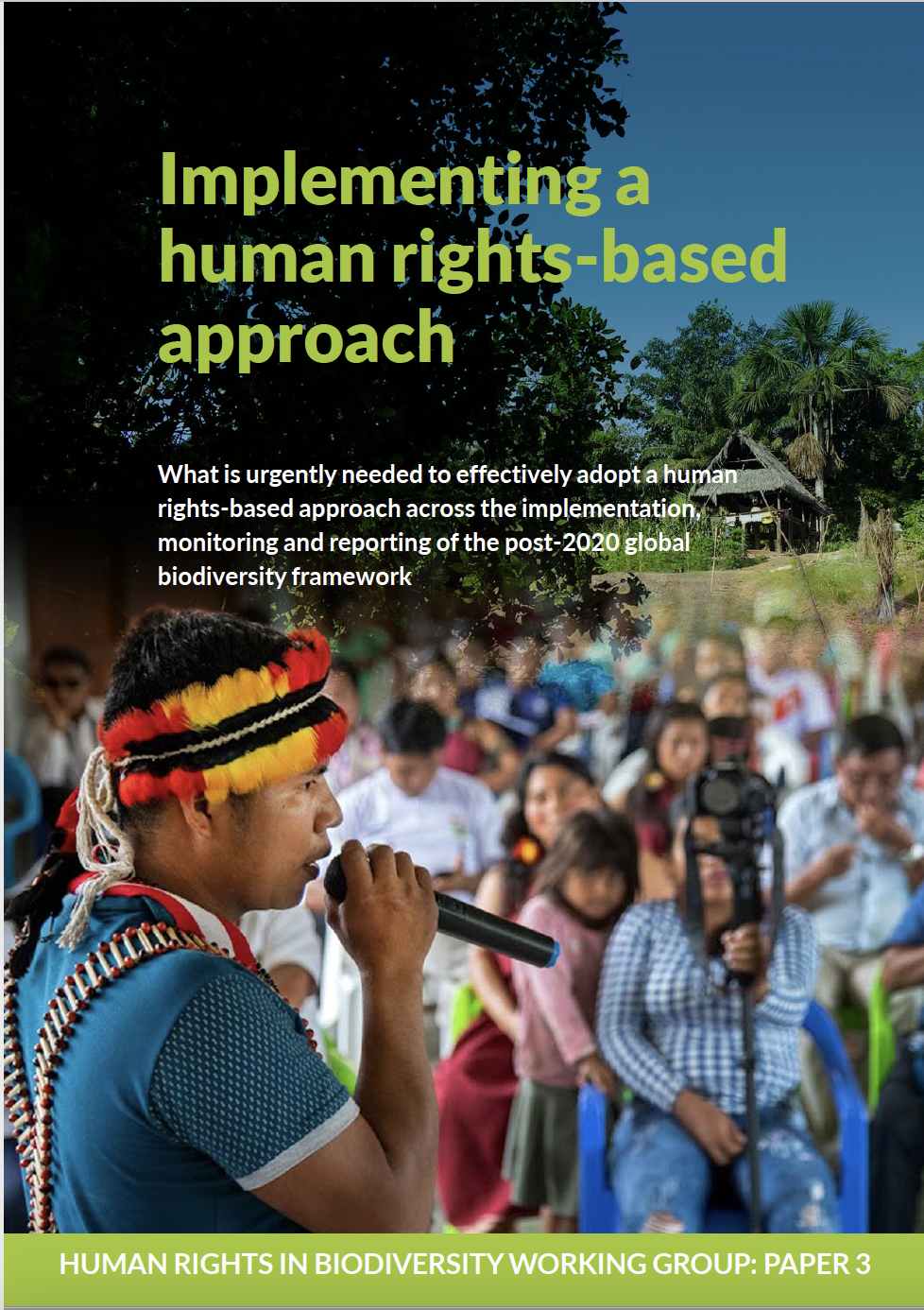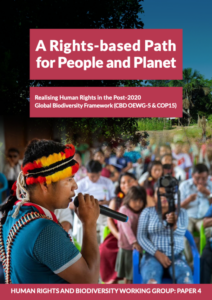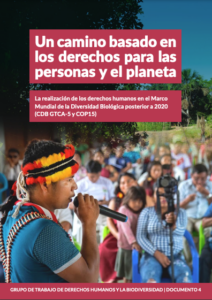 Story highlights
Story highlights
- Applying a human rights-based approach in the implementation of the new post-2020 agenda has enormous potential to facilitate transformative changes and halt biodiversity loss
- This briefing seeks to provide overarching recommendations and detailed text proposals, including for the monitoring framework, to support the effective implementation of a human rights-based approach.
- Failure to adequately incorporate the protection of human and environmental rights defenders would mean risks not only for expanding violations of human rights, but also increased destruction of biodiversity.
The global aim of ‘living in harmony with nature’ – being agreed by governments from around the world this week, at the UN in Geneva1 – can only be achieved by including strong human rights protections for the guardians of the world’s ecosystems. Indigenous Peoples and Local Communities protect and steward the vast majority of the world’s biodiversity, and it has been widely proven that nature under the stewardship of Indigenous Peoples and Local Communities is declining much less rapidly than in other areas of the world.
This briefing [LINK] (soon available in SPANISH) lays out a way forward to ensure that Human Rights are central to this agreement.
“A human rights based approach is crucial to a successful Global Biodiversity Framework. The future of any successful framework requires the integration of human rights across all issues – not just in environmental agreements, but more holistically, in agriculture, fisheries, tourism, and our entire ways of life.”
Lucy Mulenkei, Co-Chair of the IIFB.
A human rights-based approach (HRBA) applied in this agreement (the ‘Post-2020 Global Biodiversity Framework’), would mean that biodiversity policies, governance and management do not violate human rights. Those implementing such policies should actively seek ways to support and promote human rights in their design and implementation.
The effective implementation of a real human-rights-based approach requires a more holistic approach than currently suggested in the draft of the framework. It requires strengthening and improvements across all aspects of the framework but especially regarding: goals, targets, monitoring framework, enabling conditions, National Biodiversity Strategies and Action Plans (NBSAPs).
This briefing seeks to provide overarching recommendations and detailed text proposals, including for the monitoring framework, to support the effective implementation of a human rights-based approach.
The Human Rights in Biodiversity Working Group established in Chiang Mai, 2020 have collaboratively compiled this 3rd human rights analysis of ”Draft One of the post-2020 Global Biodiversity Framework”.
The authors from the Group urge the Open-ended Working Group (OEWG) on the Post-2020 Global Biodiversity Framework to effectively integrate and strengthen a human rights-based approach. As for now, the human rights-related advancements are not sufficient and without further improvement the framework risks falling short of its ambition to achieve transformative change, they argue.
With this latest brief (VOL3), the Human Rights in Biodiversity working group has published the 3rd, and thus far most hands-on policy brief on the implementation, monitoring and reporting of a human rights-based approach in the post-2020 global biodiversity framework.
Key messages on a Human-Rights-Based Approach:
- A human rights-based approach means, in simple terms, that biodiversity policies, governance and management do not violate human rights and that those implementing such policies actively seek ways to support and promote human rights in their design and implementation.
- Indigenous peoples and local communities’ ways of life and territories are part of the solution to our global crises and must be identified and supported across the framework, including through recognition of rights over lands, territories and resources, in area-based measures, in customary sustainable use, in traditional knowledge and in full and effective participation.
- The rights of women and girls to participate is enshrined in the Convention. This requires both disaggregation of data across Targets and Indicators, and the development of a specific Target (new 22) and associated indicators.
- The rights of younger and future generations, and our responsibilities to them, are intergenerational and sacred. Transformative education and full engagement of children and youth in the design and implementation of this framework will be essential to enable us to live up to those responsibilities.
- Review, reporting, and monitoring constitute critical elements of this framework. Review and refinement of the national reporting format, and development of effective non-State channels for commitments to be registered and for additional data to be provided, is essential.
- The monitoring framework, agreed indicators, data sources and means of verification can only be finally established once the global biodiversity framework is complete. This may take longer than the planned meetings in Geneva and an additional inter-sessional meeting dedicated to the monitoring framework should be called.
This human rights analysis of Draft One of the post-2020 Global Biodiversity Framework has been collaboratively compiled by members of the Human Rights in Biodiversity working group established in Chiang Mai, 2020. Members contributing included Forest Peoples Programme (FPP), CBD Alliance, Global Youth Biodiversity Network (GYBN), International Indigenous Forum on Biodiversity (IIFB), ICCA Consortium, Natural Justice, Tebtebba Foundation, WWF International, the Raoul Wallenberg Institute on Human Rights and Humanitarian Law, Friends of the Earth International, the CBD Women’s Caucus, Women4Biodiversity and SwedBio at Stockholm Resilience Centre.
1Background to resumed meetings of the Convention on Biological Diversity (CBD)
The resumed meetings of the Convention on Biological Diversity in Geneva are underway, where governments from around the world negotiate a new agreement to save nature, the Post-2020 Global Biodiversity Framework. Later this year the framework is set out to be adopted at the UN COP15 meeting in Kunming, China. The overall vision? Living in harmony with nature. In this context a human rights-based approach (HRBA) to conservation and sustainable use of biodiversity is a necessary condition for stopping biodiversity loss and degradation in an equitable and sustained way.
Further Reading
- BRIEF VOL 2 – by the Human Rights in Biodiversity working group: Applying a human rights-based approach – Guidance on the application of a human rights-based approach in the post-2020 Global Biodiversity Framework, available here.
- BRIEF VOL 1 – by the Human Rights in Biodiversity working group: Human Rights in the post-2020 Global Biodiversity Framework: Options for integrating a human-rights based approach to achieve the objectives of the Convention on Biological Diversity, available here.
- POLICY BRIEF from the UN Special Rapporteur on Human Rights and the Environment: Human Rights approaches to conserving biodiversity by David R. Boyd and Stephanie Keene August 2021, available here. The Executive Summary can be found here.
- For more information on the Thematic Workshop on Human Rights as enabling condition in the post-2020 Global Biodiversity Framework, held in Chiang Mai in February 2020, do take a look at the SwedBio webpage here.


 Implementing a human rights-based approach
Implementing a human rights-based approach La aplicación de un enfoque basado en los derechos humanos
La aplicación de un enfoque basado en los derechos humanos A Rights-based Path for People and Planet – proposals for realising human rights in the Post-2020 Global Biodiversity Framework - Paper 4
A Rights-based Path for People and Planet – proposals for realising human rights in the Post-2020 Global Biodiversity Framework - Paper 4 Un camino basado en los derechos para las personas y el planeta.La realización de los derechos humanos en el Marco Mundial de la Diversidad Biológica posterior a 2020 (CDB GTCA-5 y COP15)
Un camino basado en los derechos para las personas y el planeta.La realización de los derechos humanos en el Marco Mundial de la Diversidad Biológica posterior a 2020 (CDB GTCA-5 y COP15) Pernilla Malmer
Pernilla Malmer Ana Carolina Marciano
Ana Carolina Marciano